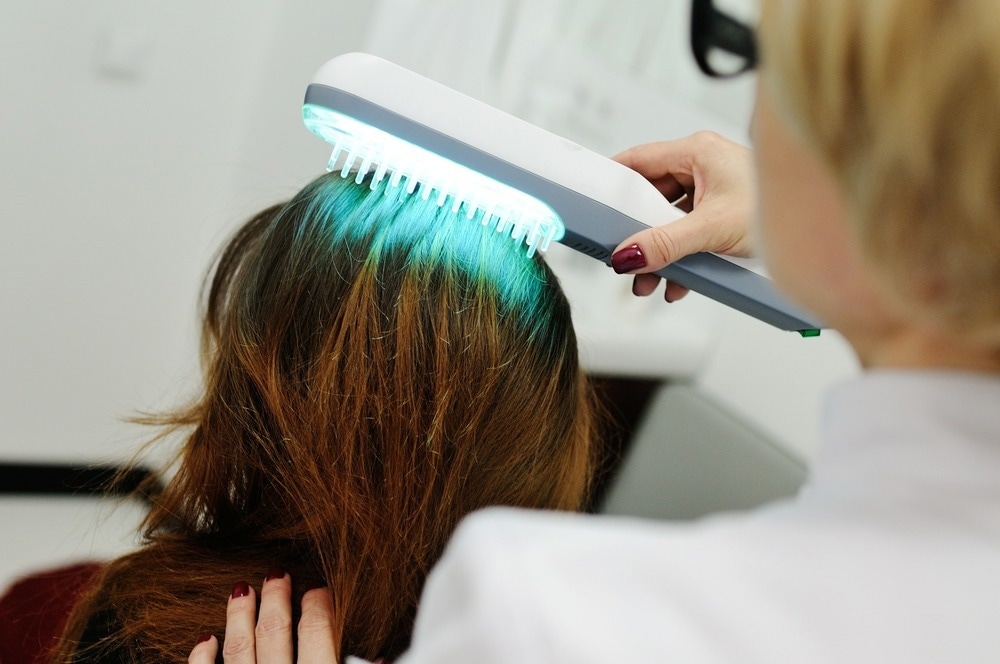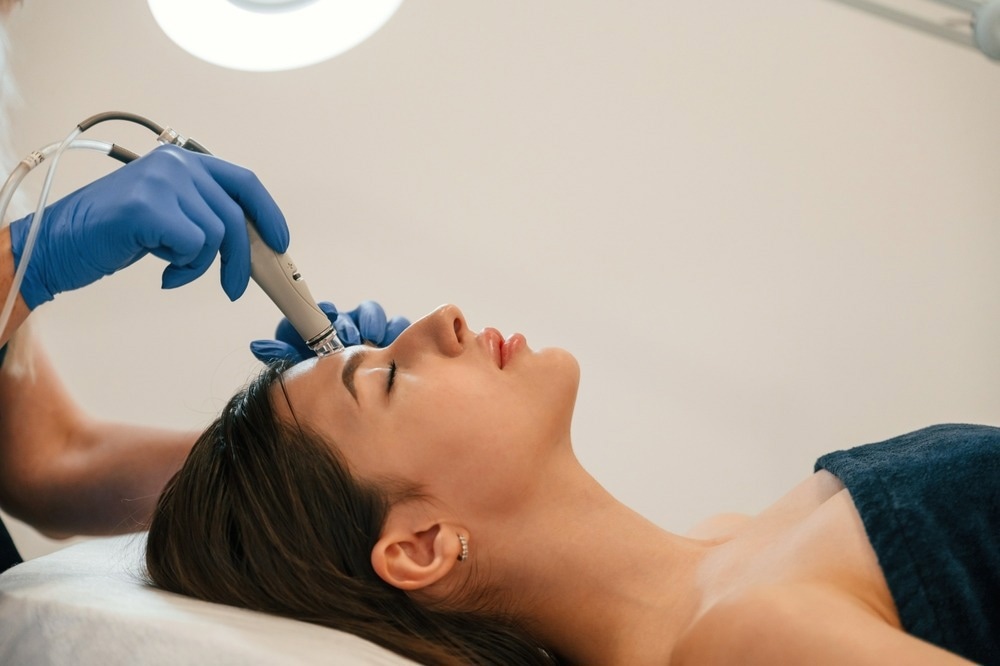LLLT: an effective phototherapy
LLLT in skin rejuvenation
LLLT in hair growth
Minor side effects of LLLT
References
Further reading
Low-level light therapy (LLLT) is a non-invasive technique that has been developed to promote tissue regeneration and repair.1 Interestingly, this therapy has displayed prominent effectiveness in hair growth and skin rejuvenation.

Image Credit: Evgeniy Kalinovskiy/Shutterstock.com
LLLT: an effective phototherapy
LLLT is a phototherapeutic technique, also referred to as photobiomodulation. In this technique, biological tissues are mostly exposed to laser light to induce a therapeutic effect. This photobiomodulation method uses photons to modify biological activities.2
LLLT makes use of coherent light sources (e.g., lasers) and non-coherent light sources (e.g., light-emitting diodes-LED). For specific applications, both light sources could be used jointly. Since the optical window for biological tissues is around 650–1200 nm, red or near-infrared light with a wavelength ranging between 600 and 950 nm is used in LLLT.1
LLLT entails the generation of a single wavelength of light without emitting any heat, vibration, or sound. In 1963, Leon Goldman was the first to reveal the effectiveness of laser in dermatology.3 In 1967, Endre Mester, a pioneer in laser medicine, observed that laser therapy could improve hair growth in mice who were being treated for cancer.4
Over the years, LLLT has been applied to reduce inflammation and pain and enhance the tissue repair process. It has also been used to prevent tissue damage and promote nerve and tissue regeneration.
LLLT in skin rejuvenation
Although conventional laser therapies, such as ablation and cutting, require high light intensity, LLLT has been associated with exposure of skin tissues to low levels of red and near-infrared (NIR) light. After low-level light exposure, the mitochondrial chromophores in skin cells absorb the photons. Subsequently, the electron transport system is triggered with an enhancement in the levels of reactive oxygen species (ROS), adenosine triphosphate (ATP) nitric oxide release, and activation of multiple signaling pathways. This results in the increase of blood flow in skin tissue.5
In recent years, LLLT has been increasingly used for the aesthetic treatment of psoriasis, inflammatory acne, scars, and fine wrinkles. LLLT can activate stem cells, which leads to tissue repair and healing. The main advantage of LLLT in the skin is the absence or generation of minor side effects.
Vitiligo is a skin pigmentation disorder that is associated with a loss of skin pigment in patches. Patients develop whitish patches across their skin. Studies have shown that LLLT can augment skin pigmentation by activating melanocyte proliferation. In addition, this treatment also downgrades depigmentation by inhibiting autoimmunity.6
LLLT has shown great promise in the treatment of acne. Mechanistically, porphyrins produced by Propionibacterium acnes, absorb light, particularly blue light, as a part of their normal metabolic function. This light absorption induces varied photochemical reactions that have an antibacterial effect.7

Image Credit: Standret/Shutterstock.com
LLLT in hair growth
Hair follicles (HF) are tunnel-shaped structures found on the epidermis, which undergo repetitive regenerative cycles. These cycles have been divided into three stages, namely, anagen, catagen, and telogen. In the anagen stage, rapid cell growth occurs. An apoptosis-driven regression phase occurs in the catagen stage, followed by telogen stage, which is the resting phase. Several growth factors are involved with HF cycling, such as fibroblast growth factor, hepatocyte growth factor, transforming growth factor- β (TGF-β), insulin-like growth factor-1 (IGF-I), and epidermal growth factor.8
A modulation in the hair cycle by LLLT has been documented to alleviate androgenetic alopecia (AGA) in both men and women. In 2007, LLLT was approved by the US Food and Drug Administration (FDA) for AGA treatment. Mechanistically, LLLT triggers anagen phase re-entry in telogen HFs. It may augment keratinocyte and fibroblast mitosis by enhancing the production of antioxidants and ROS.1 The cytochrome c oxidase (COX) gene is responsible for the absorption of low-intensity light and aiding the aforementioned functions.9
LLLT extends the length of the anagen phase and augments cell division rates in active anagen HFs. It has been documented that laser exposure normalizes the physiological regeneration of scalp HFs, which could have been affected during chemotherapy-based cancer treatment that leads to hair loss, AGA, and alopecia areata (AA).
The hair cycle modulated by LLLT causes an enhancement in hair density and diameter and a reduction in hair shedding. Several studies have also revealed that LLLT decreases inflammation, which leads to hair growth activation.
Overall, LLLT leads to a clinical improvement in alopecias. Several clinical studies have shown that LLLT is a safe and effective strategy to alleviate AGA. Importantly, this treatment was found to be effective in persons with non-scarring alopecias and those who were non-responsive to standard hair loss treatments.
Minor side effects of LLLT
A very small number of side effects have been associated with LLLT. Some patients who received LaserComb treatment experienced a temporary onset of telogen effluvium in the first couple of months of the therapy commencement. However, this condition disappeared after the continued application of LaserComb.1
In some cases, LLLT in the skin exhibited the development of minor redness, which went away without additional intervention. Some patients experienced mild itchiness, swelling, and pigmentation of the treated skin. If laser treatments are not performed correctly, patients may experience burns, blisters, and scarring on the treated skin.
References
- Pillai JK, Mysore V. Role of Low-Level Light Therapy (LLLT) in Androgenetic Alopecia. J Cutan Aesthet Surg. 2021; 14(4):385-391. doi:10.4103/JCAS.JCAS_218_20
- Avci P, Gupta A, Sadasivam M, et al. Low-level laser (light) therapy (LLLT) in skin: stimulating, healing, restoring. Semin Cutan Med Surg. 2013;32(1):41-52.
- Gianfaldoni S, Tchernev G, Wollina U, et al. An Overview of Laser in Dermatology: The Past, the Present and … the Future (?). Open Access Maced J Med Sci. 2017;5(4):526-530. doi:10.3889/oamjms.2017.130
- Hamblin MR. Photobiomodulation or low-level laser therapy. J Biophotonics. 2016; 9(11-12):1122-1124. doi:10.1002/jbio.201670113
- Algorri JF, Ochoa M, Roldán-Varona P, Rodríguez-Cobo L, López-Higuera JM. Light Technology for Efficient and Effective Photodynamic Therapy: A Critical Review. Cancers. 2021; 13(14):3484. https://doi.org/10.3390/cancers13143484
- He X, Jin S, Dai X, Chen L, Xiang L, Zhang C. The Emerging Role of Visible Light in Melanocyte Biology and Skin Pigmentary Disorders: Friend or Foe? Journal of Clinical Medicine. 2023; 12(23):7488. https://doi.org/10.3390/jcm12237488
- Boyd JM, Lewis KA, Mohammed N, et al. Propionibacterium acnes susceptibility to low-level 449 nm blue light photobiomodulation. Lasers Surg Med. 2019;51(8):727-734. doi:10.1002/lsm.23087
- Hoover E, Alhajj M, Flores JL. Physiology, Hair. StatPearls Publishing; 2024; https://www.ncbi.nlm.nih.gov/books/NBK499948/
- Petrellis MC. et al. Laser photobiomodulation of pro-inflammatory mediators on Walker Tumor 256 induced rats. J Photochem Photobiol B Bio. 2019; 177, 69-75. https://doi.org/10.1016/j.jphotobiol.2017.09.011
Further Reading
Last Updated: Jan 31, 2024